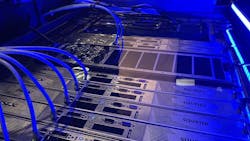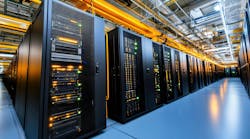Data Center Operators Look to Cooling Strategies for Greater Efficiency
This new special report series . wraps up with a deep dive into different data center cooling strategies, as well as tips on how to navigate balancing power efficiency and water usage — a process that is unique to each data center and is affected by continual technology change.
Get the full report.
Seeking a Balance
The best data center cooling strategy is to seek a balance. Since 2006, Green Grid’s Power Usage Efficiency (PUE) rating has been used as the gold standard for data center efficiency. PUE is calculated by dividing the amount of power entering a facility by the amount used to support the IT load, with the goal being to get as close to a 1:1 ratio as possible.
Although the Green Grid has stated that PUE was strictly meant to be a metric for data center operators to track their own power efficiency, it was adopted in the ANSI/ ASHRAE/IES Standard 90.1-2013, thereby providing an incentive for the use of water cooling. By shifting the burden from electricity to water, facilities can improve their PUE and thereby better comply with regulations because water consumption is invisible to the calculation.
By shifting the burden from electricity to water, facilities can improve their PUE and thereby better comply with regulations because water consumption is invisible to the calculation.
In 2011 the Green Grid introduced the Water Usage Effectiveness (WUE) metric as a corollary to PUE. WUE is calculated by dividing the amount of water a site uses for cooling, regulating humidity and producing electricity by IT equipment energy usage. It’s meant to enable data center managers to understand the effect water consumption has on the local electric grid.
Data center operators need to consider both metrics in achieving a balance that is good for both their bottom lines and sustainability objectives. Investments in alternative energy sources like wind and solar, both of which use far less water than coal-or nuclear-powered plants, can help reduce both scores.
The best course of action is to map the choice of thermal technology to the use case. Low- or zero-water solutions that also minimize power use are the most desirable. There are several types of cooling alternatives that are both water- and power-efficient.
Direct Evaporative Cooling
Direct evaporative cooling uses direct evaporation of water to produce significant cooling and humidification with low energy consumption. A wetted media like CELdek or GLASdek is used as a substrate to allow a large volume of air contact evaporating water. This is widely regarded as the simplest, most cost-effective method of cooling and humidification for air. This technology is deployed by those operators that are willing to let the air in the data center fluctuate with the outdoor air and are willing to take the risk of bringing in air from outside. To minimize these risks, direct evaporative systems must include full compressorized backup systems in the event outdoor air is not suitable for the data centers as is the case with fires that have occurred in California and other parts of the U.S.
Indirect Evaporative Cooling
Indirect evaporative cooling uses two opposing airstreams that contact a different side of a polymer heat exchanger. The outer wall of the exchanger contacts air that needs to be conditioned before it is delivered to the occupied space. The inner wall is in contact with air that comes from the ambient environment or building exhaust. Cooling occurs when water sprayed on the interior wall of a heat exchanger evaporates, imparting a cooling effect to the outer wall of the heat exchanger. This allows the airstream that contacts the outer wall to be cooled. This technology, while efficient, can consume more water than direct evaporative cooling due to the heat exchanger being between the indoor and outdoor air. The benefit of this technology over direct evaporative cooling is that it eliminates the risks associated with bringing outdoor air into the data center and the need to size backup or compressorized cooling to the full load of the data center.
The benefit of indirect evaporative cooling over direct evaporative cooling is that it eliminates the risks associated with bringing outdoor air into the data center and the need to size backup or compressorized cooling to the full load of the data center.
Evaporative Free Cooling Chillers
Evaporative free cooling chillers use ambient air that is passed through wet pads or atomizing spray systems to extend the hours the chiller can operate in free cooling mode. During warmer days evaporative cooled air is injected into the heat rejection (condenser) coils, thereby reducing energy costs. The combination of operating modes between free cooling with the adiabatic or evaporative system and lowered condensing air temperature not only provides for a more efficient chiller operation, but also reduces the peak power requirements for the chiller to operate, reducing generator and power distribution needed to support the cooling load.
Refrigerant Economizer
Refrigerant economizer is an efficient technology that leverages the phase change of refrigerants to economize or provide free cooling during times when the temperatures outside will support it. These systems use common compressor-based technology and pumps to circulate the refrigerant through the system to provide cooling. They can provide very efficient cooling without the use of water and have the best 10-year total cost of ownership because of their simple design.
Liquid Cooling – Direct-to-Chip
Liquid cooling – direct-to-chip takes water or refrigerant directly to the chip to take the heat off the hottest components within the server. Direct-to-chip cooling extracts about 80% of the heat into the liquid while the remaining heat is cooled through air cooling systems in the data center. This technique is not only an efficient means of cooling equipment but it also reduces the fan energy within the equipment, thus improving operational efficiency.
Liquid Cooling – Immersion Cooling
Liquid cooling – immersion cooling is a relatively new cooling technique that submerges computer equipment in a non-conductive fluid. Heat is removed by circulating liquid into direct contact with hot components, then through cool heat exchangers. The benefit of this approach over direct-to-chip liquid cooling is that all of the server heat is captured by the liquid, so fans can be eliminated from the servers.
Bracing for Change
Balancing power efficiency and water usage is a process that is unique to each data center and is affected by continual technology change. Operators should look for solutions that provide the best combination of PUE and WUE given local operating costs, sustainability objectives, regulations and community considerations. Facility size is an important factor in making the right choice as there is no one size that fits all. Look to hyperscale operators for ideas, as they are motivated to do some of the most innovative work in this area.
Also keep an eye on emerging trends in hardware design and AI. Component makers are constantly looking for ways to reduce power consumption, such as scaling back processor cycles or shutting down components during periods of low activity. AI-based controls will complement human operators by monitoring infrastructure at a much larger scale and adjusting workloads to optimize energy use.
Facility size is an important factor in making the right choice as there is no one size that fits all. Look to hyperscale operators for ideas, as they are motivated to do some of the most innovative work in this area.
The growing trend toward edge computing may enable further efficiencies by moving some processing to air-cooled servers in the field and relieving the load on networks and data centers.
Operators should also monitor the development of the Smart Grid and the opportunities it will present to monetize their UPS infrastructure while simplifying the path toward sustainable power generation. The field of power and water efficiency is the scene of constant innovation, making it one of the most exciting dimensions of data center operations
Catch up on the first entry — New Concepts of the Sustainable Data Center Arise Amid an Evolving Market, as well as posts that explored the potential of the Smart Grid and data center water usage.
Get the full report, “The Rise of the Sustainable Data Center,“ for a new special report from Vertiv and Data Center Frontier that explores the future of the sustainable data center and its impact on the industry.

